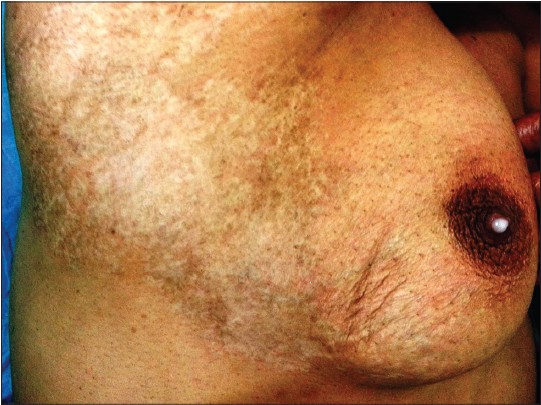Translate this page into:
Ipsilateral galactorrhea following zoster of the T4 dermatome
2 Department of Endocrinology, Pt. Bhagwat Dayal Sharma Postgraduate Institute of Medical Sciences, Rohtak, Haryana, India
Correspondence Address:
Nidhi Jindal
HNo 1151, Sector 2, HUDA, Rohtak - 124 001, Haryana
India
| How to cite this article: Jindal N, Jain V K, Aggarwal S, Kaur S. Ipsilateral galactorrhea following zoster of the T4 dermatome . Indian J Dermatol Venereol Leprol 2014;80:540-542 |
Sir,
Galactorrhea is defined as discharge of milk or milk-like secretion from the breast in the absence of parturition or beyond six months′ postpartum in a non-breastfeeding woman. [1] The secretion may be intermittent or persistent, scant or abundant, free flowing or expressible, and unilateral or bilateral. It is a relatively common problem that occurs in approximately 20% to 25% of women. [1] Herpes zoster is a rarely implicated cause for galactorrhea.
A 50-year-old postmenopausal woman with milky discharge from her right breast and pain in the right side of chest for the previous 6 months was referred from the endocrinology department. The pain was continuous, of moderate intensity, burning in nature, and associated with hyperesthesia. She had a painful vesicular eruption in the area of right breast extending up to the scapula, 12 months ago. She had no history of headache, vomiting, or decreased vision and did not take any medication except analgesics for the chest pain. Examination revealed an irregular hypopigmented atrophic patch on the right side of the chest wall extending over the right scapula in T4 dermatome [Figure - 1]. Breast examination showed no asymmetry, dimpling, or masses but did reveal a milky discharge from the right nipple. Screening biochemical investigations, thyroid function test, and serum prolactin levels were within the normal range. In the absence of systemic signs, we chose not to undertake a battery of other tests for galactorrhea, viz. serum cortisol, growth hormone, serum insulin-like growth factor levels, and imaging studies.
 |
| Figure 1: Atrophic hypopigmented scars right side, T4 dermatome |
Pain was managed with pregabalin and analgesics. For galactorrhea, she was referred to the endocrinology department where she was advised periodic assessment of serum prolactin levels as patients with isolated galactorrhea and normal prolactin levels do not require treatment if they are not bothered by the milky discharge. [1] Her serum prolactin levels on the first follow-up visit were normal and she was advised to report after another 6 months.
The history of a painful vesicular eruption and the presence of atrophic scars within a dermatome are evidence for zoster which occurred 6 months prior to the development of galactorrhea and was the possible cause, in the absence of another explanation and with normal laboratory investigations. Complications of herpes zoster can be classified into four categories according to the affected system: cutaneous, ocular, neurological, and visceral. [2] Galactorrhea is seldom described as a complication of zoster and we found only two previous reports. [3],[4],[] One case was similar to ours, whereas the other was a HIV-positive postmenopausal woman with persistent galactorrhea. The time gap between zoster and galactorrhea in one case was 6 months while it was 2 months in the other patient. [3],[4]
Galactorrhea is a benign nipple discharge that has no association with breast cancer. It is not a disease process but is a symptom that may or may not be associated with an underlying disease that needs further medical treatment. Galactorrhea is idiopathic in about 35% of cases, physiological in 14%, and occurs as a result of chest wall irritation in less than 10%. Zoster is a rarely cited cause of galactorrhea and may be mediated by stimuli sent through intercostal nerves to the posterior column of the spinal cord, to the mesencephalon, and finally to the hypothalamus, where the secretion of prolactin inhibitory factor is reduced, thereby increasing the levels of prolactin and leading to galactorrhea. [1]
| 1. |
Leung AK, Pacaud D. Diagnosis and management of galactorrhea. Am Fam Physician 2004;70:543-50.
[Google Scholar]
|
| 2. |
Kutlubay Z, Goksugur N, Engin B, Tuzun Y. Complications of Zoster. J Turk Acad Dermatol 2011;5:1-7.
[Google Scholar]
|
| 3. |
Paul TV, Spurgeon R, Jebasingh F. Visual vignette. Postherpetic neuralgia and galactorrhea. Endocr Pract 2008;14:392.
[Google Scholar]
|
| 4. |
Bateganya MH, Muhwezi J, Mugyenyi P, Kityo C, Lynen L, Zolfo M, Colebenders R. Persistent galactorrhea in a post menopausal woman with Herpes zosterand HIV-1 infection. Malawi Med J 2005;17:101-3.
[Google Scholar]
|
Fulltext Views
5,083
PDF downloads
1,664





